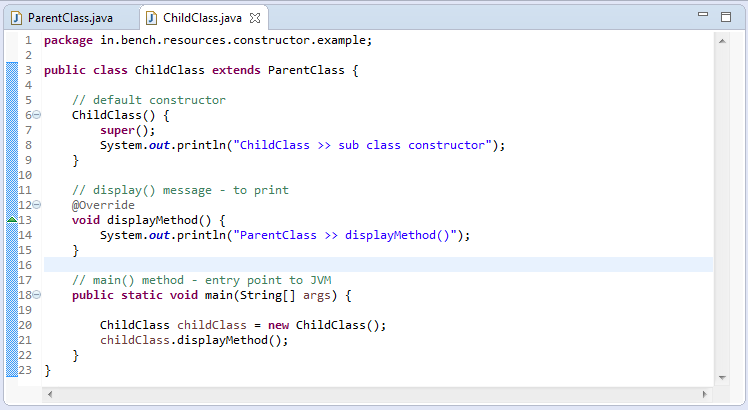
Type in the command to run the Java runtime launcher and then hit Enter.
#Java constructor super how to#
To understand how to use the super keyword to call a base class constructor, follow these 10 steps. Super's constructor unless default constructors are in place for both classes. In fact, a constructor in the derived class must call the At this point, all of the constructors within the hierarchy execute beginning with the Object constructor.How to Use the super Keyword to Call a Base Class Constructor in Java See Java: Tips and Tricks for similar articles.Ī derived Java class can call a constructor in its base class using the super keyword. Regardless of whether the superclass constructor is called implicitly or explicitly, the process of calling superclass constructors continues until the Object constructor is called. When a subclass’s constructor does not explicitly call a superclass’s constructor using super, Java inserts a call to the superclass’s no-argument constructor. The actual parameters passed in the call to the superclass constructor provide values that the constructor can use to initialize the object’s instance variables. The superclass constructor can be called from the first line of a subclass constructor by using the keyword super and passing appropriate parameters to set the private instance variables of the superclass. Subclasses do not have access to the private instance variables in a superclass that they extend. Java Swing graphical programming is not covered on the AP CS A exam, but it is a lot of fun! 9.2.2.

Take a look at the Rectangle.java and Oval.java files to see how they inherit from the Shape class in Shape.java. When the yellow panel comes up, click on either the Rectangle or the Oval button and then click and drag somewhere on the yellow panel to draw that shape.
#Java constructor super code#
String target = "LongRectangle extends Rectangle" īoolean passed = checkCodeContains(target) įor a more complex example of drawing shapes, try running this Java Swing code (or download the files here by clicking on Download on the top right and use the files in your own Java IDE). Regardless of whether the superclass constructor is called implicitly or explicitly, the process of calling superclass constructors continues until the Object constructor is called since every class inherits from the Object class.Ĭlass MPoint ) īoolean passed = getResults(expect, output, "Checking Square constructor with 1 argument void test5()

So, be sure to provide no-argument constructors in parent classes or be sure to use an explicit call to super() as the first line in the constructors of subclasses. If a subclass has no call to a superclass constructor using super as the first line in a subclass constructor then the compiler will automatically add a super() call as the first line in a constructor. In Java, the superclass constructor can be called from the first line of a subclass constructor by using the special keyword super() and passing appropriate parameters, for example super() or super(theName) as in the code below. A no-argument constructor is one that doesn’t have any parameters, for example public Person(). If a class has no constructor in Java, the compiler will add a no-argument constructor. GetResults("2+", "" + num, "Creating new Employee()", passed)

Int num = countOccurencesRegex(code, target) String target = "Employee * = new Employee" Public class RunestoneTests extends CodeTestHelperīoolean passed = getResults(expect, output, "Running main") Public boolean setName(String theNewName) Which class constructor sets the name? Which class constructor sets the id? Try creating another Employee object in the main method that passes in your name and then use the get methods to print it out.


 0 kommentar(er)
0 kommentar(er)
